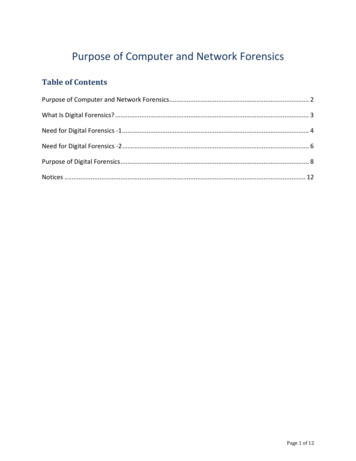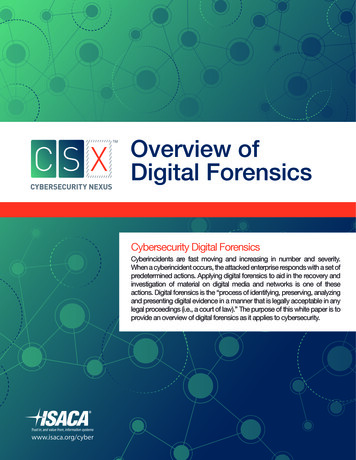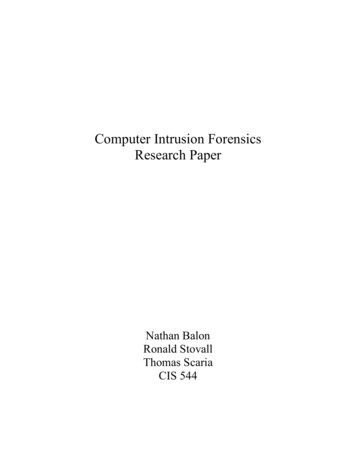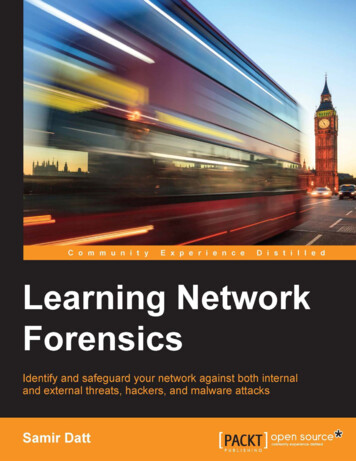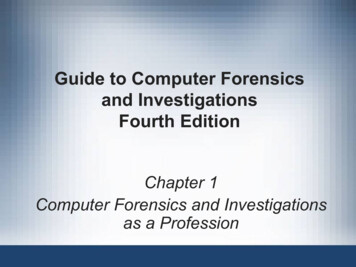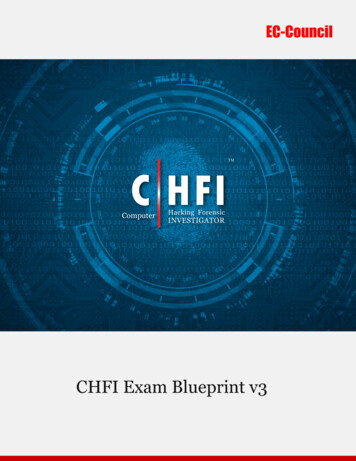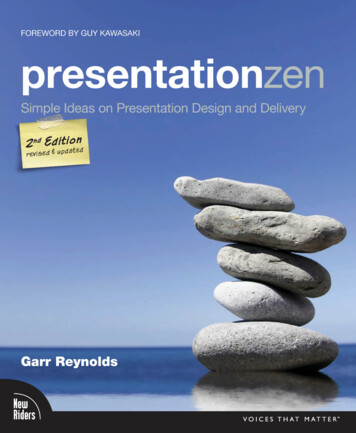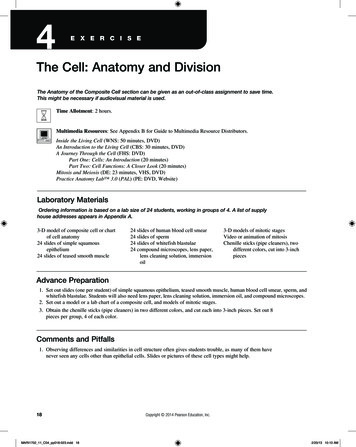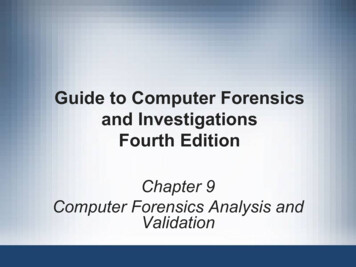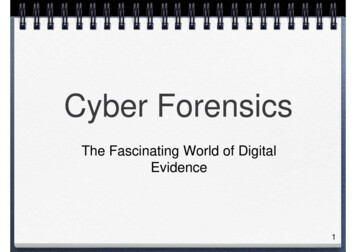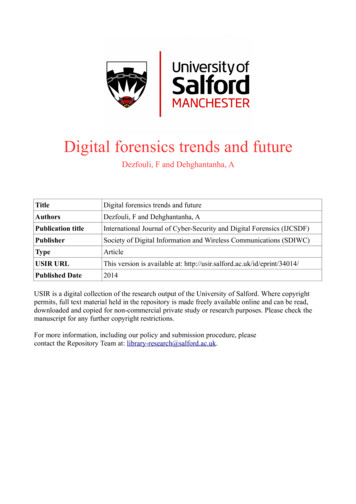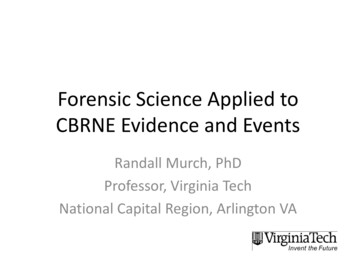
Transcription
Forensic Science Applied toCBRNE Evidence and EventsRandall Murch, PhDProfessor, Virginia TechNational Capital Region, Arlington VA
Important to Consider It will be most helpful for you to understand something aboutthe science, applications and issues to ensure that the mostappropriate laws and policies are implemented. While there are some similarities and overlaps with the issuesand concerns that you have heard about thus far, there are alsosome significant differences. Often, with CBRNE evidence and associated forensic analyses,interpretation and reporting, there are additional stakeholdersinvolved. These are not the same as those my colleagues havebeen addressing or implying. Every forensic scientist is not expert in these areas, it requiresspecialized expertise, technology and facilities. Similarly, mostexperts in CBRNE are not experts in the forensic issues.
Terms of Reference: “CBRNE” C Chemical Weapons and Hazards (including Military CW;Synthesized Poisons; Commercially Available, ToxicIndustrial Chemicals, Biotoxins) B Biological Weapons, Infectious Diseases and Biotoxins(Human, Zoonotic, Animal, Disease, Naturally ProducedToxins) R Radiological Materials (Medical and Commercial Use),Radiological Dispersal Devices N Nuclear Materials, particularly Special NuclearMaterials (SNM. Aka Fissile Materials); Nuclear Weapons E Explosives (“Homemade”, Military, Commercial,Industrial; and Associated Devices)
Forensic Exploitation ofCBRNE Evidence Information of forensic value can be obtained from thesource material itself What was done to some CBRNE materials for nefarious use(“weaponization”) can provide information of forensicvalue (e.g., biological agents) Construction or configuration of the device, delivery systemor method of dissemination can provide information ofconsiderable forensic value Methods, tools, equipment, sources used and associatedtraditional forensic evidence can be of considerable value Close collaboration with experts inweapons phenomena and effects (includingmedicine/health for chem/bio/rad)
“Forensics” and “Attribution” Forensics: Analysis and interpretation of physical evidence todetermine relevance to events, people, places, tools, methods,processes, intentions, plans– Identification and Characterization– Inclusion toward Attribution or Exclusion Scientific Attribution: Assignment of a sample of questioned originto a source of known origin to a high degree of scientific certainty(at the same time excluding origination from other sources)– attribution requires comparison of “Q” with “K”– Increasingly and more intensely, the science underlying “attribution” isbeing scrutinized, expectations are increasing for accuracy, reliability,repeatability, validity Legal & Policy Attribution: Who did it or is culpable (to acceptablelegal burden of proof or undefined policy standards)
Chemical Weapons/Hazards:Forensic Analysis Examples– Military: Nerve Agents--Sarin(“GB”), Soman (“GD”), Tabun(“GA”), “VX”; Blood Agents—Several Cyanide Compounds(also Toxic Industrial Chemicals);Blister Agents—Lewisite, SulfurMustard; Choking/Pulmonary—Phosgene, Ammonia, Chlorine,Bromine (also Toxic IndustrialChemicals)– Toxic Industrial Chemicals-- Seeabove, and Other--CertainPesticides, Ethylene Glycol– Other: Fentanyls (opioids)– Biotoxins: Abrin (Rosary Pea),Ricin (Castor Bean); Saxitoxin(marine organisms); Strychnine(Strychnos spp.), Tetrodotoxin(Puffer Fish) Examples of Nefarious Use––– Aerosolization for Effects on Targeted orLarge Populations (Agent Dependent)Targeted PoisoningsDisruption or Damage to CommercialVehicles Carrying Large Quantities orProduction Facilities Resulting in Releaseand ExposureForensic Exploitation–––––Identification of toxic substanceIdentify possible sources or productionmethodsPackaging, delivery device, dissemination,release methods/equipment; includingassociated “biometric”/impression andtrace evidenceMethod/Technique for Damaging Vessel orFacilityMedical Presentation and Effects
Biological Agents and Toxins Examples of Agents/Toxins Examples of Nefarious Use– Bacillus anthracis (“anthrax”)– Francisella tularensis (“tularemia”)– Salmonella spp./Shigella spp (foodborne pathogens)– Coxiella burnetii (“Q fever”)– Foot and Mouth Disease Virus (FMD)(animal pathogen)– Puccinia graminis Ug99 (wheat rust)– Botulinum toxin (Botox)– Ricin (from Castor Bean)Forensic Analyses Focused on Phylogenetics,Genomics, Physical-Chemical (Weaponization),Disease Presentation, Dissemination Method– 2001 Anthrax Attacks– Dissemination in public place– Contamination of food source (1984Rajneeshee, Oregon)– Localized Aerosol Dissemination– Attack against US beef or swineindustry– Attack against US wheat crop– Focused attack, specific targets, smallquantities– Targeted or Mass PoisoningEach Scenario Could Provide Significant Science ChallengesSee: “Review of the Science Used by the FBI in theAnthrax Mailing Attacks, NRC 2011“Microbial Forensics”, 2nd Ed. Elsevier 2011
Radiological Dispersal Device,aka “Dirty Bomb” Examples of Materials– Millions of legitimate sourcesworldwide (industry, medicine,research); Black market worldwide How Selected and Used byAdversary– Isotopes deemed likely for use inRDD, produced by reactors ntium-90– Dispersion of ionizingradiation using explosiveforce of IED alpha particlesbeta particlesgamma raysx-rays– Medical and health effectsdependent on presentationForensic Analysis:Source MaterialsAnd Device(as with an IED) Skin Contact Inhalation Intake via Food/Water
Nuclear Materials and Weapons“Pre-Det” and “Post-Det” Forensic Exploitation Nuclear Weapon–––Diverted or stolen weapon from declared orundeclared nuclear weapon state, particularlythose with poor security in nuclear weaponscomplex (materials inventory accountability,expertise, weapons inventory); Provided weaponfrom rogue stateUsually constructed with Uranium and/orPlutonium isotopes (Special Nuclear Materials,“fissile materials”)Requires special technical capabilities and knowhow, many levels from device construction, radiochemistry, weapons phenomena and effects Improvised Nuclear Device, Example–––––Two pieces of fissionable material, one ateither end of tube (“barrel”)Each piece is sub-critical (mass required fordetonation)HE used to blow one piece into the otherto achieve criticalityPractical with only enriched 235UForensic exploitation: Pre-blast-Device andMaterials; Post-Blast: Residues,Phenomena and EffectsSee: “Nuclear Forensics: A Capability at Risk; NRC 2010“Nuclear Forensics”: Role, State of the Art, Program Needs;APS-AAAS 2010
Forensic Analysis: Explosives, Ordnanceand Improvised Explosive Devices Chemical Analysis of Main Charge(Explosive Material) and Determinationof Possible SourcesIdentification ofComponents/Manufacturers andPossible Sources (e.g., Timing andFuzing)Exploitation ofElectronic/Communication ComponentsMaterials Analysis of Components ofMost Probative ValueConstruction/Configuration of Device(“Bombmaker’s Signature”)PackagingAssociated Evidence: e.g., Fingerprints,Trace Evidence, Internal/ExternalMarkings, Toolmarks, Binding/WrappingMaterials
Uses of Forensic Results andInterpretations from CBRNE EvidenceCriminal InvestigationsCivil InvestigationsJurisprudence & LitigationIntelligence/Counterterrorism Non-Proliferation/Counterproliferation Operational DecisionMaking Policy Decisions Did A Crime/Event or Activity ofInterest) Occur?What Happened?How Did It Occur?When Did It Occur?Where Did It Occur?Why Did It Occur?Who Was Involved?What Evidence Exists? What Does ItTell Us? How Strong are the Links?How Reliable and Credible is theEvidence?What Alternative Explanations areThere for the Evidence?Can We Defend Our Conclusions andActions?Forensic Investigation Can Generate Leads, ShapeInvestigations/Intelligence Gathering and Inform AnswersScience Alone Does Not Determine Outcome
Lead U.S. CBRNE Forensic Investigationand Analysis Capabilities Chemical Weapons Forensics: Department of Defense, FBI,Department of Energy National Labs, Specialized Contractors– Does not include forensic toxicology, drug, routine poisons (Crime & MELabs) Microbial (BW) Forensics: FBI, Department of HomelandSecurity/NBACC, Certain Universities, Department of EnergyNational Labs, Other Federal Agencies, Specialized Contractors Radiological Forensics: Department of Energy National Labs,Department of Defense, FBI Nuclear Forensics: Department of Energy National Labs, FBI,Department of Defense Explosives (Including Residues)/IED Forensics: FBI, BATF (IEDs,bulk/residue chemistry, including high explosives), Department ofDefense (ordnance, IEDs), Some State/Local Labs (small,unsophisticated devices; routine explosive residues)
CBRNE Forensic Science AlsoPursues Quality and Timely Science Appropriately educated andcredentialed scientists Laboratories that achieve ormirror accreditation, GLP Rigorous, accepted and peerreviewed scientific methods Science that informs answers toinvestigative, legal, intelligence,operational and policy questionsPolicy Issues:Does the science meet aboveexpectations of different setsstakeholders on a timely basis?What are the gaps?And can they be effectively addressed?How and how much is required? Goals for the Science– Robust Collection & Preservation ofEvidence– Relevant Exploitation of Sample– High Discrimination– Enables Comparison ofK and Q Samples– Utility Across Known, EncounteredSample Types– Accuracy– Reliability– Defined & Acceptable Error Rate– Speed & Responsiveness– Repeatability– Transferability– Validity Can Be IndependentlyEstablished– Results Probative, Interpretable,Explainable, Defensible
Examples of “Grand Challenges”with CBRNE Forensic Science Chem:– Limitations to source attribution due to nature of materials– Highly toxic; Contamination of objects/substrates with traditional probative forensic evidence Bio:–––– Discerning natural, deliberate and accidental events when diseases present similarlyDetermining information of forensic value in biologically complex samplesSubstantial unknowns with respect to microbes and behavior in environmentUnderstanding the limits of science and technology and source attribution“Rad”, RDD– Known limitations forensic analysis of pattern/impression evidence associated with dispersaldevice (fingerprints, toolmarks et al)– Limitations to determining origin of source materials Nuclear– Classified nature of weaponry and some key knowledge– Access to sensitive/classified databases necessary for effective comparative purposes Explosives/IEDs– Known limitations forensic analysis of pattern/impression evidence associated with dispersaldevice (fingerprints, toolmarks et al); materials analysis of components– Limits to what instrumental analysis of materials can providevis-à-vis source attribution, depending on materials used
Examples: Big Policy Issues forCBRNE Forensic Science Defining how much, what kind and what quality of scientificevidence is required to inform a policy decision (to take actionagainst a state or sub-state group) No standards for interpreting and communicating CBRN forensicevidence to different stakeholders How much investment is required for personnel, infrastructure andequipment for specialized capabilities (low frequency-highconsequence activities and events) How best to mirror end-to-end forensic qualityrequirements/expectations in some areas within sequestered,specialized laboratories Prioritizing and coordinating investments in the USG in Research,Development, Testing, Evaluation & Validation for stronger scientificbasis for certain disciplines Scientific “Grand Challenges” in Some Fields
American Chemical SocietyScience & the Congress Projectwith The American Statistical AssociationForensics:Science Policies toIncrease ConfidenceSeptember 26, 2012, 12:00 – 1:30 p.m., SVC 200/201#acssciconAmerican Chemical Society16
“Forensics” and “Attribution” Forensics: Analysis and interpretation of physical evidence to determine relevance to events, people, places, tools, methods, processes, intentions, plans – Identification and Characterization – Inclusion toward Attribution or Exclusio
